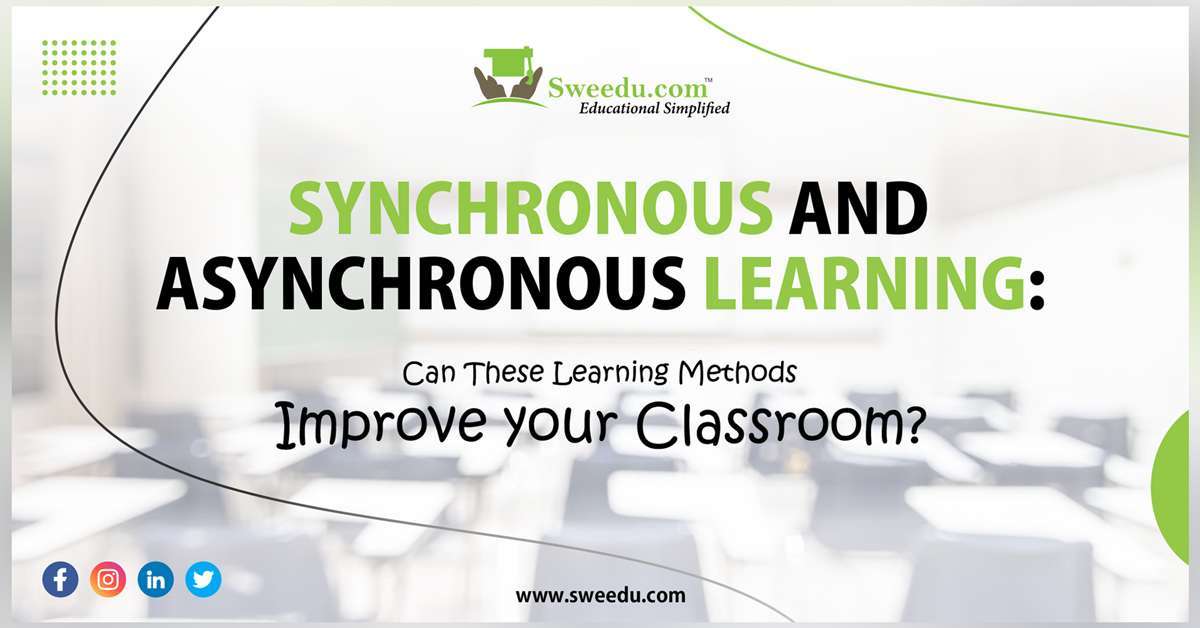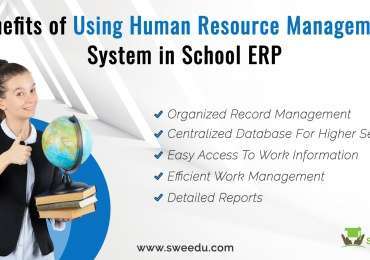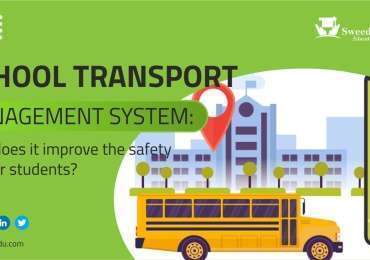
Online learning gained momentum after the pandemic. More and more educational institutes have been adopting new technologies for smart management. With these new changes, learning methods have been upgraded to match the new learning environment.
Online classrooms can use three learning methods such as synchronous, asynchronous, and hybrid learning.
u might not know about these learning methods. But that’s okay. Because in this blog, we’ll be talking about all three methods as well as which is better.
What is Synchronous Learning? How Does it Work?
Synchronous learning refers to real-time learning where students and teachers meet at a fixed time for class.
Here, all students engage with study materials online and interact with the teacher to solve any queries. This type of learning environment is structured and interactive to increase student engagement.
Online classes, traditional classes, live-streamed lectures and video conferences are all examples of synchronous learning.
What are the Benefits of Synchronous Learning?
Contemporary learning has been the go-to learning method for some time now. According to a survey, 84% of students preferred contemporary learning over noncontemporary learning because of its interactive social properties.
Let’s discuss its benefits to understand why contemporary learning has been a standard practice for so long.
1. Real-Time Communication
This learning method often uses communicative components like chat rooms, surveys, polls, shared notes and documents. These components provide students with real time communication opportunities to share ideas and expand their knowledge base.
2. Fixed Structure
Here students are provided with a fixed learning schedule, where they’re given a daily timetable set with various subjects. This structure keeps students accountable and helps them thrive in a routine without procrastination.
3. Get Immediate Feedback
With real-time communication, students can get feedback on assignments, queries or general problems. This ensures that they’re learning right, and utilizing study material information as intended.
It saves students and teachers the trouble of going through the material again in the next class or on mail later.
4. Personalized Lesson Plans
Instead of passive learning, teachers should try to analyze student’s understanding against the complexity of the content being taught. This will help them gain insights on which topic is harder to understand and will require more attention. This personalization will help them make their lesson plans better.
5. Collaborative Learning Opportunities
With contemporary learning, teachers can make lesson plans more collaborative and interactive. With live chat and discussion boards, students can work together in groups for collaborative projects and work on their social skills too
Now that we’ve discussed one learning method, let’s move on to the other.
What is Asynchronous Learning? How Does it Work?
Asynchronous learning refers to a method of learning tailored for a student’s convenience. Here, the students and teachers are not bound by a fixed schedule, meaning they engage with the course materials according to their preference mostly through an education management software or platform.
This method of learning is also known as ‘distance learning’ because students can enroll into the course no matter the location restraints. The course structure is set in units where a student has to go through the study materials on their own time.
Non-contemporary learning includes pre-recorded audio and video lectures, video tutorials/demos, reading-writing assignments, online quizzes and discussion boards for academic communications between the faculty and the students.
The student goes through the course materials as per their speed, with guidance from their teachers who provide feedback as and when needed. Here, the student assessment process also happens online.
What are the Benefits of Asynchronous Learning?
A lot of educational institutions reject the idea of asynchronous learning, saying it won’t help students learn efficiently. But as per a research article, video learning produces better outcomes than traditional methods of learning.
Let’s try to understand why it does so by diving into the benefits of non contemporary learning.
1. Flexible Schedule
This method of learning gives students control over their academic progress. This means students get to decide which class to take first, how many classes they want to take in a day and the time they want to do so.
With a flexible schedule, negative emotions like stress over being late and frustration over a fixed timetable are removed from the learning environment. This improves a student’s focus and motivation to learn, while helping them learn time management.
2. Learn at Individual Pace
No two students are the same so why should they be forced to learn at the same pace, right? With control over their schedule, students get to decide what they want to learn, and how much they want to learn in one session.
This way students can take their time while learning topics that are hard to grasp. With the study materials available offline, they can reread or re-watch it as many times as they want.
With non contemporary learning students can actually pay attention to what they study rather than worrying about keeping up with other students.
3. Cost Effective for Schools
As a teacher, having to teach the same thing over and over is a waste of their time. With this method of learning teachers have to record their lecture in the form of a video, which helps them save so much time.
When and if they feel like they want to add more content to a video, they can always re-record the video or make an extra one just for that. With this method, teachers can focus on improving student-teacher communication or providing detailed feedback during assessments.
4. Better Learning Opportunities
Unlike traditional learning methods, students get to choose the learning format i.e., audio, video or written. This non contemporary method caters to different learning styles, helping them consume information effectively.
Students can take time to think about new information they learn, process it better and develop critical thinking. This helps in creating a rich knowledge base instead of just listening to new information continuously without really understanding it.
5. Multi-tasking Options
Some students find it hard to sit in a classroom and focus all their attention on one thing. But with this learning option, they can do two things at once for better productivity, and a fun learning experience.
This is especially useful for students with day time jobs and hectic personal lives. Instead of sacrificing one thing for another, they can choose to multitask.
6. More Detailed Feedback & Reviews
In traditional learning institutions, teachers are overworked and overwhelmed, so much so that they can’t give proper attention to their students. With non contemporary learning methods teachers get more time and energy to provide a holistic learning experience.
With more free time, they can create detailed student evaluations, understand which student needs more guidance and provide comprehensive feedback on student work.
How to Choose Between Synchronous & Asynchronous Learning Methods
While both of these learning techniques have their merits, it’s difficult to choose between them. So, let’s discuss the cons of both the methods to help you get a better understanding of the two.
Cons of Synchronous Learning Modes
-
- Time Consuming (small talk, repeating information due to class disturbance)
- Fixed Schedules (no room for flexibility)
- Technical Connectivity Issues (wifi issues or device issues)
- Environmental Distractions (background, noise, family members, pets)
Cons of Asynchronous Learning Methods
-
- No social connections (having to learn alone)
- Misunderstandings (with questions, answers, concepts)
- Unavailability of Teacher (when they’re learning)
- Time Management (procrastination, poor management skills)
- Trying to Rush the Learning Process (not taking enough time to learn)
After going through the cons list, you might be confused about choosing one method for your classroom.
Well, good thing for you that you don’t have to pick one.
You can go for a hybrid learning method.
What is a Hybrid Learning Method? How Does it Work?
A hybrid method combines synchronous and asynchronous learning attributes to create the best learning environment for students. Here students are required to complete part of their course offline (on campus) and the rest virtually. For instance, a teacher could conduct course lectures offline but keep other academic activities like projects, group work, and research online using an education management software.
This kind of learning management gives the students some control over their schedule but also holds them accountable. Also, this method provides them with a social and interactive learning environment to interact with other classmates and teachers.
FAQ’s
1. What is the difference between synchronous and asynchronous learning?
Synchronous learning is real-time learning with students and teachers present in one location. Asynchronous learning is distance learning with flexible schedules where students access the study materials when they want.
2. What is an example of synchronous learning?
Educational information that is delivered and received at the same time is considered a part of synchronous learning. It includes live lectures, webinars, video conferences, and online broadcasted discussions.
3. What is an example of asynchronous learning?
When information is not delivered and received at the same time, it is asynchronous learning. It includes video lessons, pre-recorded lectures, writing assignments, and reading work.
EndNote
In this age of smart schools and online classes, it has become important to revise learning methods for better alignment with different learning styles, preferences and individual personalities.
Here’s a recap of their benefits.
Benefits of Synchronous Methods
-
- Real-Time Communication
- Fixed Structure
- Get Immediate Feedback
- Personalized Lesson Plans
- Collaborative Learning Opportunities
Benefits of Asynchronous Methods
-
- Flexible Schedules
- Learn at Individual Pace
- Cost Effective for Schools
- Better Learning Opportunities
- Multi-tasking Options
- More Detailed Feedback & Reviews
- While these two learning methods have their merits, you don’t have to choose just one. You can choose to combine both of their attributes to create a hybrid learning environment which is beneficial for both students and teachers.Another way to improve your institute’s educational environment is to use ERP software like SWEEDU.With special management software for schools, coaching classes, institutes, colleges, and universities, we cater to all educational institutes.Signup to start your free trial today and upgrade your management style with an education management software.If you enjoyed this blog, don’t forget to share it with your friends, and colleagues on social media. For any queries, use our comment section and we’ll get back to you. If you’re interested in reading more about education and ed tech, check out our other blogs.
- https://sweedu.com/wp-content/uploads/2025/05/undefined.jpeg





